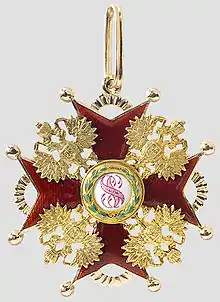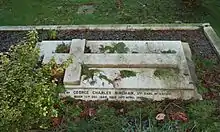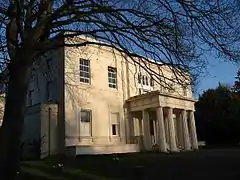George Bingham, 5th Earl of Lucan
Colonel George Charles Bingham, 5th Earl of Lucan, 1st Baron Bingham, GCVO, KBE, CB, TD, PC, DL (13 December 1860 – 20 April 1949), styled with subsidiary, courtesy title Lord Bingham from 1888 to 1914, was a British soldier and Conservative politician. From 1920 until 1928 he was one of the King's aides-de-camp, a ceremonial honour awarded to military figures which entitles the recipient to wear the aiguillette, braided ropes.
The Earl of Lucan | |
|---|---|
 The Earl of Lucan, 1943 | |
| Member of Parliament for Chertsey | |
| In office 7 July 1904 – 8 January 1906 | |
| Preceded by | John Arthur Fyler |
| Succeeded by | Francis Marnham |
| Conservative Chief Whip in the House of Lords | |
| In office 1929–1940 | |
| Preceded by | The Earl of Plymouth |
| Succeeded by | The Lord Templemore |
| Personal details | |
| Born | 13 December 1860 |
| Died | 20 April 1949 (aged 88) |
| Nationality | British |
| Political party | Conservative |
| Spouse(s) | Violet S B Spender Clay |
| Children |
|
| Alma mater | Harrow, Sandhurst. |
Background and education
Lucan was the son of Charles Bingham, 4th Earl of Lucan, and Lady Cecilia Catherine Gordon-Lennox.[1] He was educated at Harrow, and later at Sandhurst.
Military career


Lucan was commissioned into the Rifle Brigade in 1881. He fought in the Bechuanaland Expedition (1884-1885) and was awarded the Order of the Nile 3rd Class. He first retired with the rank of Captain in 1896. In 1900 he joined the 1st London Rifle Volunteers (territorial army) as a Major, rising to the rank of Colonel. He fought in the First World War, where he was mentioned in despatches. He was awarded the Order of St. Stanisla(u)s of Russia in the second of its three classes. He gained the rank of Honorary Brigadier-General in 1917 and Lieutenant-Colonel in 1923.
Political career
He was for 18 months a Member of Parliament, for the Chertsey constituency in Surrey. He was the successful Conservative candidate at a by-election on 7 July 1904 and was defeated in the 1906 United Kingdom general election by the Liberal candidate in a landslide for that party. In August 1914 he was elected as an Irish representative peer, enabling him to sit in the House of Lords. He served under David Lloyd George, Bonar Law and Stanley Baldwin as a Lord-in-Waiting (government whip in the House of Lords) from 1920 to 1924 and under Baldwin from 1924 to 1929. The latter year he was appointed Captain of the Honourable Corps of Gentlemen-at-Arms, a post he held until the government fell later that year and again in the National Government from 1931 to 1940.
Orders of merit
He was appointed Companion, Order of the Bath (C.B.) in 1919. He was appointed Knight Commander, Order of the British Empire (K.B.E.) in the 1920 civilian war honours list.[2]
Magistrate, County Lieutenancies and aide-de-camp to George V
Lucan was appointed High Sheriff of Mayo for 1902–03.[3] He later held for life the family's customary office of Deputy Lieutenant (D.L.) of County Mayo, to which was added for him that of Middlesex; honorary roles receiving invitations to open local buildings and to become patrons of local charities. He served as Justice of the Peace in local magistrates courts in Middlesex.
He was awarded the Territorial Decoration (T.D.) in 1920. He held the office of Lord-in-Waiting between 1920 and January 1924 then December 1924 to 1929; specifically serving as aide-de-camp to HM King George V 1920-1928 entitling him during that time to wear the braided ropes, the aiguilette. In the Palace of Westminster he was Captain of the Gentlemen-at-Arms January–July 1929 and 1931 and 1940.
Grant of the United Kingdom peerage
He was created Baron Bingham, of Melcombe Bingham, in the County of Dorset on 26 June 1934, rendering him and his male heirs of the body, lawfully begotten, entitled to sit as of right in the House of Lords. This was circumscribed to a co-opting system to reduce from hundreds the number to 92 hereditary peers under the House of Lords Act 1999. His son after inheriting the title was a Labour peer.
Death, settled land and free estate
He died while staying at the Cavendish Hotel, Eastbourne, usually resident at 19 Orchard Court, Portman Square in 1949. His son swore net probate assets of £14,464 (rounded); two months later his son-in-law and James Hamilton, Marquess of Hamilton swore to settled land whose free value was £119,153 (rounded). Together these figures are equivalent to £4,756,000 in 2019, taxed subject to exemptions and divided among the estate heirs.[4] His grandson and heir in the title, a major gambler experiencing heavy losses, was presumed dead and a murderer after his disappearance; his son in turn inherited the heritable titles.
Family
In 1896 Lucan married Violet Sylvia Blanche Spender Clay, daughter of Joseph Spender Clay and Elizabeth Sydney Garrett, with whom he had four children:[1]

- George Charles Patrick Bingham, 6th Earl of Lucan (24 November 1898 – 21 January 1964)
- Lady Barbara Violet Bingham (17 August 1902 – 17 December 1963), who married John Bevan, CB, MC
- Hon. John Edward Bingham (29 February 1904 – 1992)
- Lady Margaret Bingham (16 September 1905 – 17 August 1977) married Field Marshal the 1st Earl Alexander of Tunis, son of James Alexander, 4th Earl of Caledon
Lord Lucan died in April 1949, aged 88, succeeded in the earldom by his eldest son George through whom the title continues as at 2021. The Dowager Countess of (Lady) Lucan died after their eldest son in 1972; her net estate at death was sworn as £26,433 that year; she lived at 40 Orchard Court, Portman Square.[5]
Estates of land

In 1922 Lucan sold his family's home since 1803 at Laleham House and most of its remaining land; the purchaser of the house was the Catholic Church. Lucan had earlier widened his father's gift of land which formed Laleham Park for the community.[6][7] The house was in the late 20th century lightly restored and converted into 9 self-contained apartments.
Ancestry
| Ancestors of George Bingham, 5th Earl of Lucan | ||||||||||||||||||||||||||||||||||||||||||||||||||||||||||||||||||||||||||||||||||||||||||||||||||||||||||||||||||||||||||||||||||||||||||||||||||||||||||||||||||||||||||||||||||||||||||||||||||||||||||||||||||||||||||||||||||||||||||||||||||||||||||||||||||||||||||||||||||||||||||||||||||||||||||||||||||||||||||||||||||||||||||||||||||||||||||||||||||||||||||||||||||||||||||||||||||||||||||||||||||||||||||||||||||||||||||||||||||||||||||||||||||||||||||||||||||||||||||||||||||||||||||||||||||||||||||||||||||||||||||||||||||||||||||||||||||||||||||||||||||||||||||||||||||||||||||||||||
|---|---|---|---|---|---|---|---|---|---|---|---|---|---|---|---|---|---|---|---|---|---|---|---|---|---|---|---|---|---|---|---|---|---|---|---|---|---|---|---|---|---|---|---|---|---|---|---|---|---|---|---|---|---|---|---|---|---|---|---|---|---|---|---|---|---|---|---|---|---|---|---|---|---|---|---|---|---|---|---|---|---|---|---|---|---|---|---|---|---|---|---|---|---|---|---|---|---|---|---|---|---|---|---|---|---|---|---|---|---|---|---|---|---|---|---|---|---|---|---|---|---|---|---|---|---|---|---|---|---|---|---|---|---|---|---|---|---|---|---|---|---|---|---|---|---|---|---|---|---|---|---|---|---|---|---|---|---|---|---|---|---|---|---|---|---|---|---|---|---|---|---|---|---|---|---|---|---|---|---|---|---|---|---|---|---|---|---|---|---|---|---|---|---|---|---|---|---|---|---|---|---|---|---|---|---|---|---|---|---|---|---|---|---|---|---|---|---|---|---|---|---|---|---|---|---|---|---|---|---|---|---|---|---|---|---|---|---|---|---|---|---|---|---|---|---|---|---|---|---|---|---|---|---|---|---|---|---|---|---|---|---|---|---|---|---|---|---|---|---|---|---|---|---|---|---|---|---|---|---|---|---|---|---|---|---|---|---|---|---|---|---|---|---|---|---|---|---|---|---|---|---|---|---|---|---|---|---|---|---|---|---|---|---|---|---|---|---|---|---|---|---|---|---|---|---|---|---|---|---|---|---|---|---|---|---|---|---|---|---|---|---|---|---|---|---|---|---|---|---|---|---|---|---|---|---|---|---|---|---|---|---|---|---|---|---|---|---|---|---|---|---|---|---|---|---|---|---|---|---|---|---|---|---|---|---|---|---|---|---|---|---|---|---|---|---|---|---|---|---|---|---|---|---|---|---|---|---|---|---|---|---|---|---|---|---|---|---|---|---|---|---|---|---|---|---|---|---|---|---|---|---|---|---|---|---|---|---|---|---|---|---|---|---|---|---|---|---|---|---|---|---|---|---|---|---|---|---|---|---|---|---|---|---|---|---|---|---|---|---|---|---|---|---|---|---|---|---|---|---|---|---|---|---|---|---|---|---|---|---|---|---|---|---|---|---|---|---|---|---|---|---|---|---|---|---|---|---|---|---|---|---|---|---|---|---|---|---|---|---|---|---|---|---|---|---|---|---|---|---|---|---|---|---|---|---|---|---|---|---|---|---|---|---|---|---|---|---|---|---|---|---|---|---|---|---|---|---|---|---|---|---|---|---|---|---|---|---|---|---|---|---|---|---|---|---|---|---|---|---|---|---|---|---|---|---|---|---|---|---|---|---|---|
| ||||||||||||||||||||||||||||||||||||||||||||||||||||||||||||||||||||||||||||||||||||||||||||||||||||||||||||||||||||||||||||||||||||||||||||||||||||||||||||||||||||||||||||||||||||||||||||||||||||||||||||||||||||||||||||||||||||||||||||||||||||||||||||||||||||||||||||||||||||||||||||||||||||||||||||||||||||||||||||||||||||||||||||||||||||||||||||||||||||||||||||||||||||||||||||||||||||||||||||||||||||||||||||||||||||||||||||||||||||||||||||||||||||||||||||||||||||||||||||||||||||||||||||||||||||||||||||||||||||||||||||||||||||||||||||||||||||||||||||||||||||||||||||||||||||||||||||||||
References
- The Peerage
- "No. 31840". The London Gazette (Supplement). 30 March 1920. p. 3759.
- The County Families of the United Kingdom. Edition 59.
- Probate Calendars of England and Wales of 1949 p.432
- Probate Calendars of England and Wales of 1972 p.672
- "Laleham Village – Around and About". Spelthorne Borough Council. Archived from the original on 3 November 2007.
- Historic England. "Laleham Abbey (Grade II*) (1187014)". National Heritage List for England. Retrieved 1 March 2015.
External links
- Hansard 1803–2005: contributions in Parliament by the Earl of Lucan
- . . Dublin: Alexander Thom and Son Ltd. 1923. p. – via Wikisource.
| Parliament of the United Kingdom | ||
|---|---|---|
| Preceded by John Arthur Fyler |
Member of Parliament for Chertsey 1904–1906 |
Succeeded by Francis Marnham |
| Political offices | ||
| Preceded by The Earl of Lucan |
Representative peer for Ireland 1914–1949 |
Office lapsed |
| Preceded by The Earl of Onslow |
Lord-in-waiting 1920–1929 |
Succeeded by The Lord Templemore |
| Preceded by The Earl of Plymouth |
Captain of the Honourable Corps of Gentlemen-at-Arms 1929 |
Succeeded by The Earl of Cavan |
| Government Chief Whip in the House of Lords 1929 |
Succeeded by The Earl De La Warr | |
| Preceded by The Earl of Cavan |
Captain of the Honourable Corps of Gentlemen-at-Arms 1931–1940 |
Succeeded by The Lord Snell |
| Preceded by The Lord Marley |
Government Chief Whip in the House of Lords 1931–1940 |
Succeeded by The Lord Templemore |
| Peerage of Ireland | ||
| Preceded by Charles Bingham |
Earl of Lucan 1914–1949 |
Succeeded by George Bingham |
| Peerage of the United Kingdom | ||
| New creation | Baron Bingham 1934–1949 |
Succeeded by George Bingham |